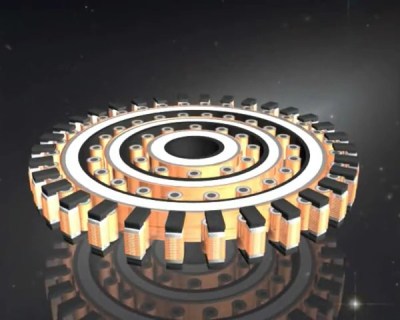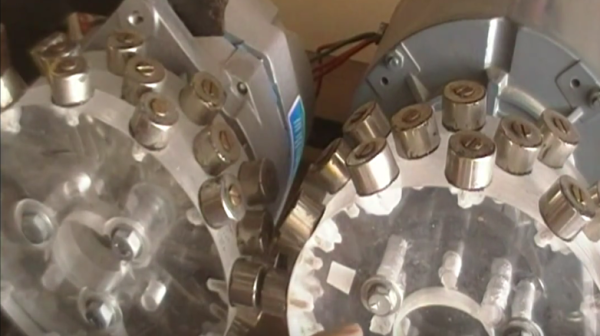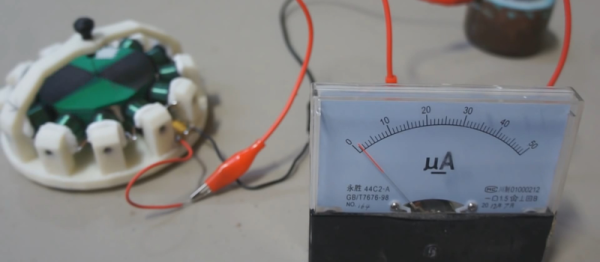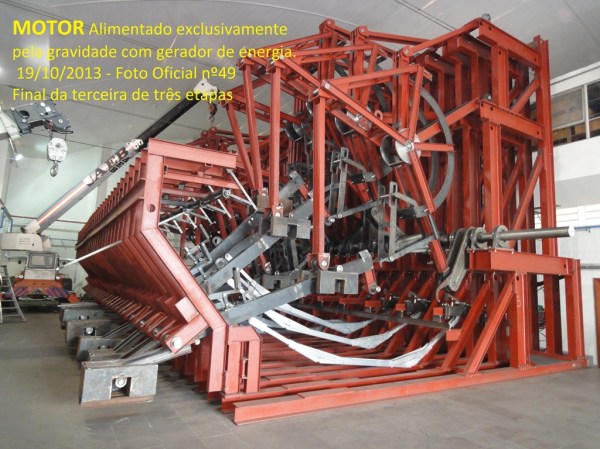We received belated word this week of the passage of Ward Christensen, who died unexpectedly back in October at the age of 78. If the name doesn’t ring a bell, that’s understandable, because the man behind the first computer BBS wasn’t much for the spotlight. Along with Randy Suess and in response to the Blizzard of ’78, which kept their Chicago computer club from meeting in person, Christensen created an electronic version of a community corkboard. Suess worked on the hardware while Christensen provided the software, leveraging his XMODEM file-sharing protocol. They dubbed their creation a “bulletin board system” and when the idea caught on, they happily shared their work so that other enthusiasts could build their own systems.
perpetual motion9 Articles
A Brief History Of Perpetual Motion
Conservation of energy isn’t just a good idea: It is the law. In particular, it is the first law of thermodynamics. But, apparently, a lot of people don’t really get that because history is replete with inventions that purport to run forever or produce more energy than they consume. Sometimes these are hoaxes, and sometimes they are frauds. We expect sometimes they are also simple misunderstandings.
We thought about this when we ran across the viral photo of an EV with a generator connected to the back wheel. Of course, EVs and hybrids do try to reclaim power through regenerative braking, but that’s recovering a fraction of the energy already spent. You can never pull more power out than you put in, and, in fact, you’ll pull out substantially less.
Not a New Problem
If you think this is a scourge of social media and modern vehicles, you’d be wrong. Leonardo da Vinci, back in 1494, said:
Oh ye seekers after perpetual motion, how many vain chimeras have you pursued? Go and take your place with the alchemists.
There was a rumor in the 8th century that someone built a “magic wheel,” but this appears to be little more than a myth. An Indian mathematician also claimed to have a wheel that would run forever, but there’s little proof of that, either. It was probably an overbalanced wheel where the wheel spins due to weight and gravity with enough force to keep the wheel spinning.
Simulating A Real Perpetual Motion Device
Perpetual motion and notions of ‘free energy’ devices are some of those pseudo-science topics that seem to perpetually hang around, no matter how many times it is explained how this would literally violate the very fabric of the Universe. Even so, the very notion of a device which repeats the same action over and over with no obvious loss of energy is tempting enough that the laws of physics are employed to effect the impossible in a handy desktop format. This includes the intriguing model demonstrated by [Steve Mould] in a recent video, including a transparent version that reveals the secret.
This particular perpetual motion simulator is made by [William Le] and takes the form of metal balls that barrel down a set of metal rails which turn upward so that each metal ball will land back where it started in the top bowl. To the casual informed observer the basic principle ought to be obvious, with magnetism being a prime candidate to add some extra velocity to said metal ball. What’s less obvious is the whole mechanism that makes the system work, including the detection circuit and the tuning of the parameters that tell the device when its electromagnet should be on or off.
When [Steve] figured that he could just make a transparent version using the guts from the one he purchased, he quickly found out that even with [William]’s help, this wasn’t so easy. Ultimately [William] hand-crafted a transparent version that shows the whole system in its entire glory, even if this is somewhat like demonstrating a magic trick in an easy to follow manner.
Continue reading “Simulating A Real Perpetual Motion Device”
Overunity, Free Energy And Perpetual Motion: The Strange Side Of YouTube
Spend enough time on YouTube, and you’ll eventually find yourself in one of the many dark corners hiding within it. No, I’m not talking about the comments. In this case, I mean the many videos dedicated to free energy, overunity devices, perpetual motion machines, or anything else that violates the laws of thermodynamics by trying to get out more energy than is put in. The human race has been reaching for impossible dreams of perpetual motion and free energy for just about all of recorded history. Now it’s convenient to find them all in one place.
 Browsing the tubes, it’s easy to break free energy videos down into two major groups: enthusiasts and scammers. Catching a scammer is easy – they’re looking for money. Somewhere in the video or description will be a link to a website with more information. Eventually that will lead you to a place where the scammer attempts to part you and your hard-earned money.
Browsing the tubes, it’s easy to break free energy videos down into two major groups: enthusiasts and scammers. Catching a scammer is easy – they’re looking for money. Somewhere in the video or description will be a link to a website with more information. Eventually that will lead you to a place where the scammer attempts to part you and your hard-earned money.
Names like John Searl, Muammer Yildiz, and M. T. Keshe go here. Searl especially deserves note because he’s been at it for decades. Supposedly, his “Searl Effect Generator” SEG has been built several times, but the prototypes generate so much power they create their own anti-gravity field and fly off into space. Obviously this man and his staff need your money to continue their work. Scammers deserve disdain and public shaming. These are the folks who know their “discoveries” are nothing more than snake oil.
On the other side of the coin lie the enthusiasts. These are the backyard tinkerers, the ones who put down their computers, pick up their tools, and try to build something. Sounds a lot like the average Hackaday reader, doesn’t it? I have to admit I went into this article with the same disdain for the enthusiasts that I have for the scammers, possibly even more. In some cases, these are the folks who truly believe they can have a chance to violate the laws of thermodynamics. Inevitably these folks fail to build free energy generators, overunity devices, or whatever their pursuit is, but they all do seem to learn something in the process. A lot can be said about the builds themselves. Some of these are awesome devices. Even if they don’t work for their intended purpose, they are great demonstrations of magnetism or chemistry. This is where I had a change of heart. If someone wants to spend their time working on an impossible hack, then more power to them. I may not think they have any chance of success, but at the very least, they’ll learn how to build.
Continue reading “Overunity, Free Energy And Perpetual Motion: The Strange Side Of YouTube”
EZ-Spin Motor Spins “Forever”
Now this isn’t a perpetual motion machine, but it’s darn close. What [lasersaber] has done instead is to make the EZ Spin, an incredibly efficient motor that does nothing. Well, nothing except look cool, and influence tons of people to re-build their own versions of it and post them on YouTube.
The motor itself is ridiculously simple: it’s essentially a brushless DC motor with a unique winding pattern. A number of coils — anywhere from six to twenty-four — are wired together with alternating polarity. If one coil is a magnetized north, its two neighbors are magnetized south, and vice-versa. The rotor is a ring with permanent magnets, all arranged so that they have the same polarity. A capacitor is used for the power source, and a reed switch serves as a simplistic commutator, if that’s even the right term.
As the motor turns, a permanent magnet passes by the reed switch and it makes the circuit. All of the electromagnets, which are wound in series, fire and kick the rotor forwards. Then the reed switch opens and the rotor coasts on to the next position. When it gets there the reed switch closes and it gets a magnetic kick again.
The catch? Building the device so that it’s carefully balanced and running on really good (sapphire) bearings, entirely unloaded, and powered with high impedance coils, leads to a current consumption in the microamps. As with most motors, when you spin it by hand, it acts as a generator, giving you a simple way to charge up the capacitor that drives it. In his video [lasersaber] blows on the rotor through a straw to charge up the capacitor, and then lets it run back down. It should run for quite a while on just one spin-up.
The EZ Spin motor is absolutely, positively not perpetual motion or “over-unity” or any of that mumbo-jumbo. It is a cool, simple-to-build generator/motor project that’ll definitely impress your friends and challenge you to see how long you can get it running. Check out [lasersaber]’s website, this forum post, and a 3D model on Thingiverse if you want to make your own.
Hackaday Links: April 19, 2015
Bang & Olufsen have made some pretty amazing equipment for a long, long time. That last part can become a problem. [Oliver] found the electrolytic caps on his Beomaster 2400 were causing problems. He completely recapped the unit, all the electrolytics anyway, and the pictures of the process are nothing short of eye-candy.
The closure of the Bacman forums marks the end of an era. For years this has been among the top (okay, it’s definitely been the top one but we don’t want to start a flamewar) sites for handheld and console modding. Here’s just one random example of the many projects we covered from that community (note that main link is now sadly 404). The closure message cites the near-absolute death of modding. We haven’t thought about it much, but these mods were futuristic. Then smartphones.
Fans of How It’s Made and 3D printing will want to tune in on April 30th at 9pm EST. The show does a fantastic job of showing off the amazing story behind how all the stuff in our lives comes to be visited LulzBot in Loveland, Colorado for a segment on the manufacturing process of a 3D printer.
We’re not sure why we didn’t lead with this: All celebrate, for humanity is saved! The secret behind getting something out of nothing has been discovered. This reactionless generator has been tested at efficiencies as high as 250%. We’re working on a way to bottle all that extra juice and sell it at outrageous prices.
The thing about free energy is that you become dependent on it. What if the laws of physics return from vacation and the thing stops working? Then you have a robot apocalypse with all kinds of hidden messages and puzzles in it.
Gravity-Powered Generator: Real Or Fake?
You thought we forgot about your favorite Hackaday comment game, didn’t you? Well, not only is ‘Real or Fake?’ back with a new installment, but this time it concerns everybody’s favorite impossibility: perpetual motion machines! It’s likely that you’ve already seen the photos of Brazilian energy group RAR Energia’s generator “powered exclusively by gravity” (translated). If you’re rolling your eyes and exclaiming “this is so last year..” you might want to scroll down to the bottom of the page; they’re still building this monstrosity and they’ve included some diagram images. Perhaps someone who reads Portuguese can better translate the claim that the devices are “demonstration models with capacity to generate 30kW.” Oh, didn’t you know? There are two of them now: one in Brazil that is presumably functioning, and a second under construction in Gilman, Illinois.
Now, before you all scream “Photoshopped,” take a gander at a FotoForensics analysis of one of the images, where ELA (error level analysis) seems to indicate consistent levels of compression. EXIF data shows the pictures were shot with a Sony DSC-WX5 and saved in PhotoScape. It may be simpler than that: you can easily recognize the same employees in different shots from different angles, and there are quite a lot of photos. RAR Energia’s most recent endeavor—a second machine in Gilman Illinois—seems to have been erected in the past two months. The Gilman warehouse is located on property belonging to bio-diesel manufacturing firm Incobrasa Industries (named a “Company of the [RAR Energia] group” on the RAR Energia site). Here’s a little internet sleuthing for your consideration: a photo of the completed warehouse and a Google maps link to the location in question (40.763176, -88.012706). Note the distinctly shaped building in the background (another view here, during construction), which can be found due south of the location indicated in the Google maps link. We’re not suggesting that you completely rule out image manipulation, but if it’s Photoshopped, it’s a damned elaborate job.
Unfortunately, there aren’t any videos demonstrating motion or any explanation for how the system works other than vagaries about perpetual energy. So, does this thing exist—and did this company really build two of them? Does it work…or, well, somehow do something?

















